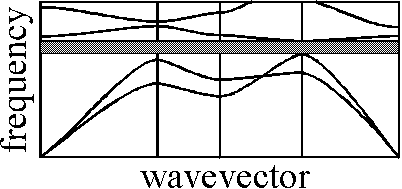Super Opal: the Photonic Insulator
Natural opal will reflect light incident in certain directions, but in this material there is always some direction at which light can penetrate. Although opal looks pretty, it only becomes scientifically interesting if we can engineer things so that, at least for some frequencies, light is completely excluded. Such a material we christen super-opal and it has much in common with semiconductors and insulators within which electrons are forbidden in certain ranges of energy.

On the left is a sketch of the optical band structure that a super-opal
might possess: note the complete absence of states in the shaded range
of frequencies whatever the direction of the wave vector.
|
One point should be stressed: an optical insulator is much more than a dark piece of space: strike a match in a dark room and there is light. Even without the match there are zero point fluctuations of the electromagnetic field. In the super opal there is nothing in this frequency range. Try to 'strike a match', for example by introducing an excited atom into the material, and nothing happens. The atom cannot decay because the material will not accept the light. Not only that, but there are not even any zero point fluctuations. That is the key to the importance of these materials. |
What Use are Photonic Insulators?
|